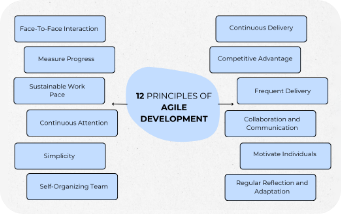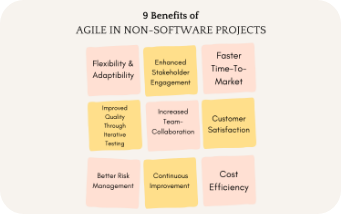Limited Time Offer: Full Feature Access. Plans start @$13 for 11 users Get Started Now
Agile methodologies, initially developed for the software industry, have rapidly gained traction in various non-software domains. The principles of Agile, rooted in flexibility, collaboration, and adaptability, prove equally effective in enhancing project management and product development in non-IT sectors.
At its core, Agile is more than a set of practices; it's a mindset that emphasizes customer satisfaction, collaboration, and responding to change. This mindset can be applied successfully to non-software projects, such as marketing campaigns, construction projects, event planning, and product development.

Agile principles, initially crafted for software development, have proven to be highly adaptable and beneficial across various industries beyond the realm of coding and programming.
These principles can be successfully applied to non-software development projects, enabling teams to embrace flexibility, collaboration, and iterative progress.
Here are 12 key principles of Agile adapted for non-software development contexts:
1. Customer Satisfaction through Continuous Delivery: Prioritize delivering valuable outcomes to your customers consistently, seeking their feedback throughout the project's lifecycle to ensure alignment with their evolving needs.
2. Welcome Change for Competitive Advantage: Embrace change as a natural and beneficial aspect of project development, staying open to adjusting plans and strategies to maintain a competitive edge in a dynamic environment.
3. Frequent Delivery of Incremental Value: Break down projects into smaller, manageable increments, delivering tangible value regularly. This iterative approach ensures that stakeholders receive continuous benefits rather than waiting for the entire project to be completed.
4. Collaboration and Communication: Foster a collaborative culture within your team and with stakeholders. Open and transparent communication is key to building a shared understanding of goals and maintaining alignment throughout the project.
5. Motivated and Trusted Individuals: Empower and trust your team members to make decisions. Provide them with the autonomy to excel in their roles, fostering a sense of ownership and accountability.
6. Face-to-Face Interaction: Prioritize direct, face-to-face communication whenever possible. This promotes a deeper understanding among team members and reduces the risk of miscommunication.
7. Working Solutions as a Measure of Progress: Evaluate progress based on tangible results rather than extensive documentation. Working prototypes, models, or drafts serve as more meaningful indicators of advancement.
8. Sustainable Work Pace: Maintain a sustainable pace to avoid burnout and ensure the long-term effectiveness of the team. Strive for a balance between productivity and the well-being of team members.
9. Continuous Attention to Technical Excellence: Prioritize high-quality work by emphasizing technical excellence. This commitment ensures the durability and adaptability of the project deliverables.
10. Simplicity: Strive for simplicity in design, processes, and communication. Eliminate unnecessary complexities to enhance clarity and efficiency.
11. Self-organizing Teams: Encourage teams to self-organize, allowing them to decide how best to accomplish their tasks. This empowerment fosters creativity and a sense of responsibility among team members.
12. Regular Reflection and Adaptation: Incorporate regular retrospectives into your project lifecycle. Encourage the team to reflect on what's working well, what could be improved, and adapt their processes accordingly for continuous enhancement.
By incorporating these Agile principles into non-software development projects, teams can cultivate a culture of adaptability, collaboration, and continuous improvement, resulting in more successful and resilient outcomes.
By embracing flexibility, prioritizing customer satisfaction, and fostering a culture of collaboration, teams can navigate the complexities of various projects with greater agility.
The emphasis on continuous delivery, iterative progress, and regular reflection ensures that projects not only meet evolving stakeholder needs but also maintain a focus on sustainable excellence.
Start by setting clear project objectives and identifying key stakeholders. Understand their needs, expectations, and priorities to align the project's direction with customer requirements.
Develop a project backlog or task list that includes all the work to be done. Prioritize tasks based on importance and urgency, allowing teams to focus on high-priority items first.
Divide the project into manageable time-bound phases or sprints. These sprints should have well-defined goals and outcomes that can be achieved within a set timeframe.
Hold daily stand-up meetings to facilitate communication among team members. These brief meetings help identify and address obstacles quickly, ensuring that the project stays on track.
Regularly review progress and gather feedback from stakeholders. Use this feedback to adapt and refine the project as needed. The iterative nature of Agile allows for continuous improvement.

In the fast-paced and ever-evolving landscape of project management, the Agile methodology has emerged as a beacon of adaptability and efficiency.
Originally developed for software development, Agile principles have found application across various industries, revolutionizing the way teams approach projects.
We'll delve into the nine key benefits of Agile methodology that make it a game-changer for organizations striving for success in today's dynamic business environment.
1. Flexibility and Adaptability: Agile methodology thrives on change. Its iterative approach allows teams to adapt to evolving requirements, market shifts, and stakeholder feedback. This flexibility ensures that projects stay aligned with the rapidly changing landscape.
2. Enhanced Stakeholder Engagement: Agile places a strong emphasis on collaboration and continuous communication with stakeholders. Regular feedback loops enable real-time adjustments, ensuring that the end product meets the expectations of both internal and external stakeholders.
3. Faster Time-to-Market: Agile's iterative cycles, known as sprints, lead to incremental and frequent deliveries of valuable features. This not only allows for continuous improvement but also accelerates the time-to-market, giving organizations a competitive edge.
4. Improved Quality through Iterative Testing: Agile integrates testing into the development process from the outset. With each iteration, testing is performed, and feedback is incorporated, resulting in higher product quality and fewer defects by the end of the project.
5. Increased Team Collaboration: Agile methodologies promote cross-functional teams that collaborate closely throughout the project. This collaborative environment enhances communication, breaks down silos, and fosters a shared sense of ownership, leading to higher team morale and productivity.
6. Customer Satisfaction: The iterative and customer-centric nature of Agile ensures that the end product aligns with customer expectations. Regular feedback loops allow for adjustments, reducing the risk of delivering a product that doesn't meet customer needs.
7. Better Risk Management: Agile's incremental approach enables teams to identify and mitigate risks early in the project. By addressing potential issues during each iteration, teams can adapt their strategies, minimizing the impact of unforeseen challenges.
8. Continuous Improvement Culture: Agile is not just a methodology; it's a mindset. The regular retrospectives and feedback loops encourage a culture of continuous improvement. Teams reflect on their processes, identify areas for enhancement, and adapt accordingly.
9. Cost-Efficiency: Agile's focus on adaptability and early risk identification contributes to cost-efficiency. By catching issues early in the development process, organizations can avoid costly rework and deliver a product that aligns more closely with stakeholder expectations.
As organizations navigate the complexities of the modern business landscape, the benefits of Agile methodology shine through as a beacon of success.
From enhanced flexibility and stakeholder engagement to faster time-to-market and improved team collaboration, Agile principles offer a holistic approach to project management that fosters adaptability, efficiency, and customer satisfaction.
Embracing the Agile mindset is not just a methodology shift; it's a strategic move toward resilience, innovation, and sustained success in an ever-changing world.